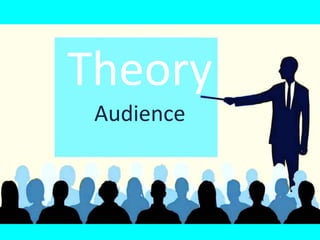
Audience theory lecture
- 2. Demographic Categories • What groups are these categories broken up into? – Gender Identity – Age – Race – Sexuality – Education – Occupation – Income – Social Economic Background
- 3. Demographic Categories • Gender Identity https://www.bigtalkeducation.co.uk/rse-information-and-support-for-schools/sex-gender/ https://www.healthline.com/health/different-genders • Age – Children 0-14 – Teenagers 15-24 – Adults 25-44 – Middle Aged 45-64 – Old 65+ • Race – Ethnicity/Country of origin/Cultural Background • Sexuality https://www.healthline.com/health/different-types-of-sexuality • Education – What level of education you have achieved (college, university, post-graduate etc) • Occupation – What job you have • Income – How much money you make • Social Economic Background – What social class you/your family are (upper class, middle class, working class) – ABC1 or C2DE
- 4. NRS Social Grades • The NRS social grades were developed by the National Readership Survey to classify magazine and newspaper readers. • Now they are used by many other organisations and have become a standard for market research. • NRS Social grades are a way in which people are grouped depending upon their jobs or the jobs of their parents.
- 5. NRS Social Grades Table Grade Social class Chief Income Earner's Occupation (% of Pop. 2008) A upper middle class Higher managerial, administrative or professional. (4%) B middle class Intermediate managerial, administrative or professional (23%) C1 lower middle class Supervisory or clerical and junior managerial, administrative or professional (29%) C2 skilled working class Skilled manual workers (21%) D working class Semi and unskilled manual workers (15%) E Those at the lowest levels of subsistence Casual or lowest grade workers, pensioners and others who depend on the welfare state for their income (8%)
- 6. Types of Audience • Primary Audiences – The planned, main target audience for a media product – Sometimes referred to as key demographic • Secondary Audiences – A different audience who interacts with a media product who is not the main audience
- 7. Types of Audience • Primary and Secondary Audiences example • Primary audience – Girls aged 6 – 11 • Secondary audience – Men aged 18 - 35
- 8. Task • Complete three examples in your pro-forma discussing who the primary and secondary audience is and how the content would appeal to them. • If you haven't seen the film, make a guess from the poster • When considering the secondary audience, think about who would go along with the primary audience to the cinema
- 9. Consumption Theory • The Hypodermic Needle Model – Where an audience immediately believes and accepts what it is told by the media
- 10. Consumption Theory • The Hypodermic Needle Model – The 1938 radio broadcast of War of the Worlds had a section of the show set as a news show reporting on an alien invasion. – This caused the American audiences to panic believing the invasion to be real
- 11. Consumption Theory • The Hypodermic Needle Model – Allows us to reflect upon the media’s influence upon the public, forming collective opinion and belief – Suggests the audience will just accept what is presented to us in the media. Instead, we are more likely to make rational judgements based on our own experiences.
- 12. Task • Provide a definition and example of what the Hypodermic Needle model is and how it works.
- 13. Consumption Theory • The Uses and Gratifications Model – This theory discusses the ways in which audiences interact with the media to help understand why we use it. – This has been separated into 4 main categories • Information • Personal Identity • Integration and Social Interaction • Entertainment
- 14. Consumption Theory • The Uses and Gratifications Model • Using the information below choose one example from each section and relate to your own life • Example- Information > I use the BBC news website to find out information Information - Finding information/news - Seeking advice or help with decision making - Satisfy curiosity - To learn Personal Identity - Reinforcing personal values - Developing behavioural traits - Identify with valued other in the media (aspiration figure- real or fictional) Integration and Social Interaction - Identifying with others - Belonging - Topic for social interaction - A substitute for real-world companionship... Entertainment - Escapism - Relaxation - Enjoyment
- 15. Consumption Theory • The Uses and Gratifications Model – Allows us to identify the needs in our lives that we fill with media products – Assumes audiences actively engage and seek out the media to fulfil a need or desire
- 16. Uses and Gratification Task • Using examples, discuss how you use the media to fulfil each of the 4 uses and gratifications Information - Finding information/news - Seeking advice or help with decision making - Satisfy curiosity - To learn Personal Identity - Reinforcing personal values - Developing behavioural traits - Identify with valued other in the media (aspiration figure- real or fictional) Integration and Social Interaction - Identifying with others - Belonging - Topic for social interaction - A substitute for real-world companionship... Entertainment - Escapism - Relaxation - Enjoyment
- 17. Consumer Generated Content • The audience contributing and creating content that will be used in a media product • What would be an example of this?
- 18. Consumer Generated Content • Examples – YouTube • Users create their own videos and submit them to a YouTube to use to generate money – Instagram • Users submit images, wavering their ownership of images allowing Instagram to use the images commercially – Little Big Planet/Disney Infinity • Users are given the tools and encouraged to create content for the game.
- 19. Consumer Generated Content • What are the advantages to media producers? • Why would the audience generate content?